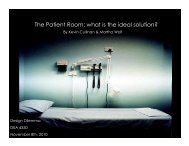The role of physical design and informal communication
The role of physical design and informal communication
The role of physical design and informal communication
You also want an ePaper? Increase the reach of your titles
YUMPU automatically turns print PDFs into web optimized ePapers that Google loves.
Average Time (mm:ss)<br />
01:44<br />
01:26<br />
01:09<br />
00:52<br />
00:35<br />
00:17<br />
00:00<br />
Social<br />
Administrative<br />
Being Taught<br />
Seeking Assistance<br />
Seeking Advice<br />
Discussing Patient Care<br />
Providing Assistance<br />
Task<br />
Providing Advice<br />
Validation<br />
Figure 22 Average time <strong>of</strong> a single interaction for each <strong>communication</strong> task<br />
3.3.2 Analysis by Person<br />
a) Frequency<br />
Table 4 shows the percent <strong>and</strong> frequency <strong>of</strong> who the GN interacted with over<br />
the entire eight weeks <strong>of</strong> data collection <strong>and</strong> the average frequency during an 8-hour<br />
shift. Note that there were two additional GNs on the unit during the data collection<br />
period. Over one third <strong>of</strong> activities were done alone, 20.4% <strong>of</strong> activities were done in<br />
the patient room, 14.7% <strong>of</strong> interactions were with a Nurse, <strong>and</strong> 13.9% were with the<br />
Orientor. During an average 8-hour shift, the GN interacted 107 times with a patient,<br />
77 times with a Nurse, 72 times with the Orientor, <strong>and</strong> only 14 times with a Doctor<br />
(Figure 23).<br />
73<br />
Other







